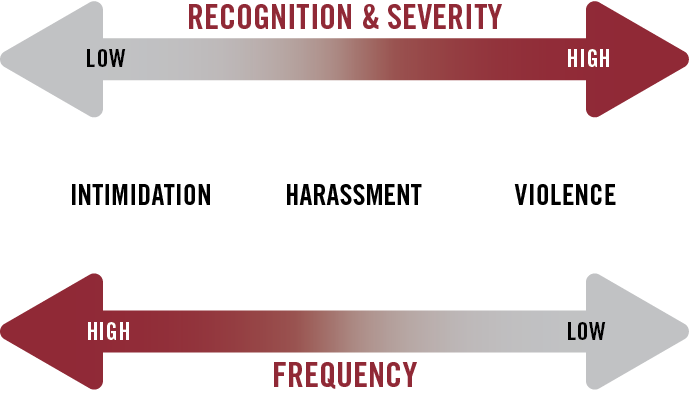Under the University’s Hazing Policy (which strictly prohibits all hazing) an individual commits hazing by intentionally, knowingly or recklessly causing, coercing or forcing another individual to engage in or endure any of the following for the purpose of pre-initiation activities, pledging, initiating, holding office, admitting or affiliating into or with an organization, or for the purpose of continuing, reinstating or enhancing an individual’s membership or status in an organization:
- Conduct or conditions that violate University policy or local, state or federal law.
- Physical brutality or any other conduct or conditions that pose a substantial risk of physical injury or death, including, but not limited to, whipping, striking, punching, beating, paddling, electric shock, placing harmful substances on or in the body, excessive exercise or calisthenics, branding or exposure to the elements.
- The consumption of any food, alcohol, drug, nonalcoholic liquid or other substance that could adversely affect the physical health or safety of the individual.
- Sexual humiliation or brutality, such as forced nudity or an act of sexual penetration, or both.
- An unreasonable act of restraint, including confinement or sleep deprivation.
- Any activity that would subject the individual to extreme mental stress, such as forced conduct that could result in extreme embarrassment, or other forced activity that could adversely affect the mental health or dignity of the individual.
Alabama law similarly defines hazing, making it a criminal act.
The Spectrum of Hazing – It’s All Hazing

Adapted from Allan, 2005; Allan & Kerschner, 2020, The Spectrum of Hazing™, this graphic represents how frequency of hazing incidents is inversely correlated with the severity and recognition of hazing incidents (i.e., as an act is more severe and more widely recognized as hazing, it is generally less common in occurrence than lesser recognized and less severe acts of hazing).
Even if it's less severe or less commonly recognized as hazing, all of these actions qualify as hazing and violate the Hazing Policy, Code of Student Conduct, and state law. For more descriptions of hazing, see the examples below.
Intimidation
- Lies, purposeful deception
- Assigning demerits or punishment
- Forced silence
- Social isolation of new members
- Use of demeaning names
- Expecting a member to carry certain items with them at all times
Harassment
- Verbal abuse
- Threats or implied threats
- Asking members to wear humiliating clothing
- Forced servitude
- “Skit nights” with humiliating acts
- Sleep deprivation
- Sexual simulations
- Requiring new members to learn songs or chants
Violence
- Forced or coerced use of food, alcohol or other drugs
- Beating, addling, any form of physical assault
- Branding
- Staged kidnappings
- Sexual assault
- Forced consumption of vile substances
Examples
More specific examples of hazing activities (which violate University policy and the law) include, but are not limited to:
- Unreasonable interference with a student’s academic performance
- Forced actions or inactions that demean or disgrace an individual
- Forced or coerced consumption of food, alcohol, drugs or any other substance
- Required periods of silence
- Forced or coerced wearing of inappropriate apparel
- Forced or coerced exclusion from a social contact
- Servitude that is of personal benefit to individual members (driving, cooking, cleaning individual rooms, serving meals, picking up laundry, washing cards, purchasing items on another’s behalf, moving furniture, etc.)
- Any unnecessary physical contact, including, but not limited to, whipping, beating, paddling, branding, piercing, tattooing or forced exercises.
- Placement of undesirable substances on or in an individual’s body
- Staging any form of lineup or event where the individuals are yelled or cursed at
- Creation of unnecessary fatigue, which includes, but is not limited to, physical activity or depravation of sleep
- Requiring total or partial nudity at any time or otherwise causing indecent exposure
- Calisthenics, such as sit-ups, push-ups, wall sits, bows and tows, etc.
- Forced or coerced actions that violate the law or the Code of Student Conduct (stealing, painting objects, destroying/damaging property, harassing others, etc.)
- Restricting daily personal hygiene practices (showering, brushing teeth, etc.)
- Carrying items for no constructive purpose (lighters, tobacco/nicotine products, bricks, etc.)
- Kidnapping or involuntarily dropping or abandoning a person off campus without return transportation
- Testing/quizzing on meaningless information with no constructive or educational purpose
- Unreasonable exposure to weather or the elements or exposure to extreme or unreasonable conditions (temperature, size, noise, air quality, etc.)
- Any other activity that could be reasonably viewed as subjecting others to embarrassment, degradation or humiliation
- Deprivation of food or water